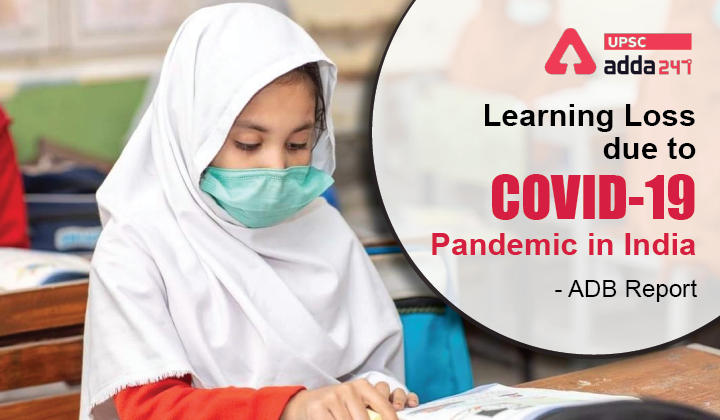Table of Contents
Economic Impact of COVID Related School Closures- Relevance for UPSC Exam
- GS Paper 2: Governance, Administration and Challenges- Issues relating to development and management of Social Sector/Services relating to- Health; Education.
ADB Report on Learning Loss due to COVID in News
- Recently, a new working paper was published by the Asian Development Bank (ADB), identifying extent of learning losses faced by children due to COVID-19 Pandemic.
- ADB Paper is titled as ‘Potential Economic Impact of COVID-19 related School Closures’.
Key Findings of ADB Report on Economic Impact of COVID Related School Closures
- GDP Loss: The gross domestic product (GDP) of India would see the highest decline in South Asia due to learning losses for the young.
- India is among the countries with the longest school closures during the COVID-19 pandemic.
- In terms of absolute change, India experiences the highest GDP decline in South Asia, at about $98.84 billion in 2030.
- In percentage terms, its GDP decreases by 0.34% in 2023, 1.36% in 2026, and 3.19% in 2030.
- Potential Economic Impact: ADB report states that starting with a $10.5 billion dent in 2023, India’s economy could take a nearly $99 billion hit by 2030, translating into a 3.19% reduction in GDP from the baseline growth trends.
- Global share: India may account for over 10% of the global GDP decline of $943 billion estimated by the ADB on account of earning losses in 2030.
- By 2030, jobs for skilled labour expected to decline by 1%, and unskilled labour by 2% in India.
- Rural-Urban divide: ADB study notes that India has notable enrolment in secondary education and among students in rural areas. Pandemic-induced school closures have also been more extensive there.
- Due to poor internet access and connectivity in rural areas, the poorest and second wealth quintile have been worst-hit due to pandemic led school closures and subsequent potential economic losses.
- Migration to already burgeoning unskilled labour force: The ADB study said that the Learning and earning losses in India are significant because a notable portion of the impacted population will migrate to the unskilled labour force.
- A large part of India’s work force is constituted by unskilled labour — 408.4 million as per the ADB paper’s estimates, compared to 72.65 million skilled workers.
The Editorial Analysis: A language ladder for an education roadblock
Reasons of Huge Economic Impact due to COVID-19 Led School Closures
- India has the highest number of children enrolled in primary and secondary education among the Asian economies covered in the paper, at 255.74 million.
- The number of students in tertiary education were second only to China at 36.39 million, as per January 2022 data used for the research.
- Due huge number of students enrolled in the school education in India, Economic losses due to COVID related school closures are significant, especially in the long term.
ADB Report- Suggestions for India
- Increased Investment: ADB paper suggests that government must increase investment in the education and skills with a focus on narrowing the digital divide.
- It is important to keep school-age children in education as much as possible by providing financial support and incentives, while giving additional support for skills training to youth already out of school
- Assessment for Impacted Students: Government should also help students recover “lost opportunities” by conducting assessments among impacted children.
- Identify and Bridge the learning Gaps: Effective learning programs should be devised to offer appropriate support such as tutoring or special classes and help them to bridge the learning gap.
- Focusing on the Most Disadvantaged Group of Students: Governments need to direct adequate funding and resources to young populations most affected by closures, such as those from the poor, rural and socially disadvantaged groups.





 TSPSC Group 1 Question Paper 2024, Downl...
TSPSC Group 1 Question Paper 2024, Downl...
 TSPSC Group 1 Answer key 2024 Out, Downl...
TSPSC Group 1 Answer key 2024 Out, Downl...
 UPSC Prelims 2024 Question Paper, Downlo...
UPSC Prelims 2024 Question Paper, Downlo...




